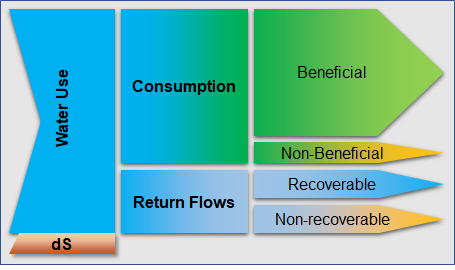The overall project objective is to compile an inventory of agricultural field interventions and develop a training package to evaluate Real Water Savings from irrigated fields, to systems and basins. A guidance document is developed for agricultural field interventions by compiling a literature database containing published experiences and results of various interventions. Impacts on water savings and crop yields are summarized in this inventory and translated into the guidance document. The training package includes a user-friendly Real Water Savings evaluation tool, a comprehensive manual, case study applications and a link with the inventory compiled in the guidance document. Training workshops will be conducted, aiming participants from target countries (e.g. Nepal and Vietnam) and aligning with existing FAO work in Asia. Feedback from the training will be used to update and refine the training package. The training package will be set-up so that it can be used independently, including clear examples, questions and answers, and do-it-yourself guidance.
In irrigated agriculture options to save water tend to focus on improved irrigation techniques such as drip and sprinkler irrigation. These irrigation techniques are promoted as legitimate means of increasing water efficiency and “saving water” for other uses (such as domestic use and the environment). However, a growing body of evidence, including a key report by FAO (Perry and Steduto, 2017) shows that in most cases, water “savings” at field scale translate into an increase in water consumption at system and basin scale. Yet despite the growing and irrefutable body of evidence, false “water savings” technologies continue to be promoted, subsidized and implemented as a solution to water scarcity in agriculture.
The goal is to stop false “water savings” technologies to be promoted, subsidized and implemented. To achieve this, it is important to quantify the hydrologic impacts of any new investment or policy in the water sector. Normally, irrigation engineers and planners are trained to look at field scale efficiencies or irrigation system efficiencies at the most. Also, many of the tools used by irrigation engineers are field scale oriented (e.g. FAO AquaCrop model). The serious consequences of these actions are to worsen water scarcity, increase vulnerability to drought, and threaten food security.
There is an urgent need to develop simple and pragmatic tools that can evaluate the impact of field scale crop-water interventions at larger scales (e.g. irrigation systems and basins). Although basin scale hydrological models exist, many of these are either overly complex and unable to be used by practitioners, or not specifically designed for the upscaling from field interventions to basin scale impacts. Moreover, achieving results from the widely-used FAO models such as AquaCrop into a basin-wide impact model is time-consuming, complex and expensive. Therefore, FutureWater is developing a simple but robust tool to enhance usability and reach, transparency, transferability in data input and output. The tool is based on proven concepts of water productivity, water accounting and the appropriate water terminology, as promoted by FAO globally (FAO, 2013). Hence, the water use is separated in consumptive use, non-consumptive use, and change in storage (Figure 1).

A complete training package is developed which includes a training manual and an inventory of possible field level interventions. The training manual includes the following aspects: 1) introduce and present the real water savings tool, 2) Describe the theory underlying the tool and demonstrating some typical applications, 3) Learn how-to prepare the data required for the tool for your own area of interest, 4) Learn when real water savings occur at system and basin scale with field interventions.
The REWAS tool can be downloaded here.
Publicaciones relacionadas
2021 - FAO Water Reports 46
Guidance on Realizing Real Water Savings with Crop Water Productivity Interventions
Van Opstal, J., P. Droogers, A. Kaune, P. Steduto, C. Perry
2020 - FutureWater Report 199
Training Manual: Crop Water Productivity Options to Achieve Real Water Savings
Droogers, P., A. Kaune, J.D. Van Opstal, P. Steduto, C. Perry
2020 - FutureWater Report 200
REWAS: REal WAter Savings tool: Technical Document
Kaune, A., P. Droogers, J.D. Van Opstal, P. Steduto, C. Perry
2020 - FutureWater Report 198
Guidance on Realizing Real Water Savings with Crop Water Productivity Interventions
Van Opstal, J.D., P. Droogers, A. Kaune, P. Steduto, C. Perry


